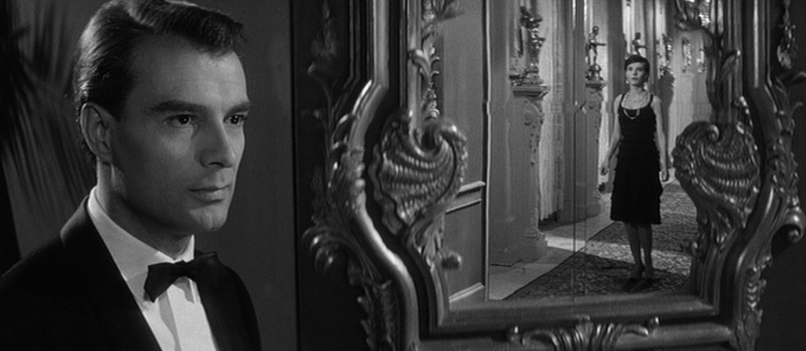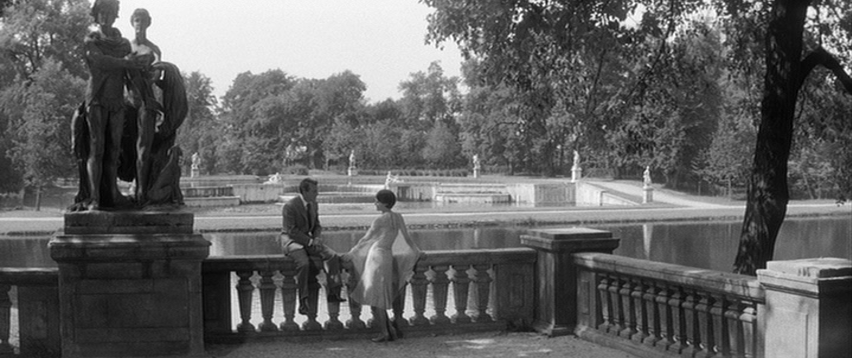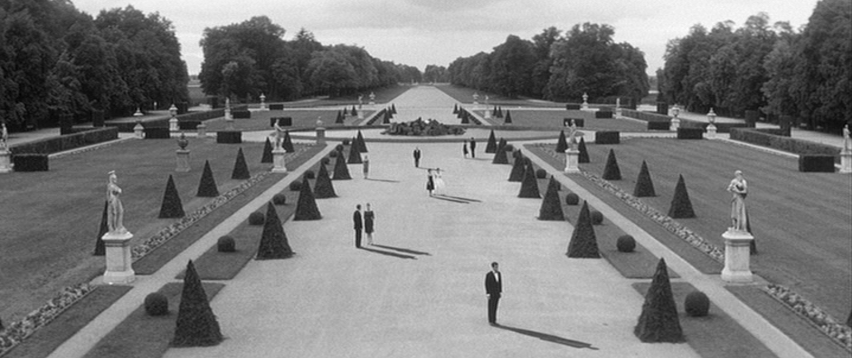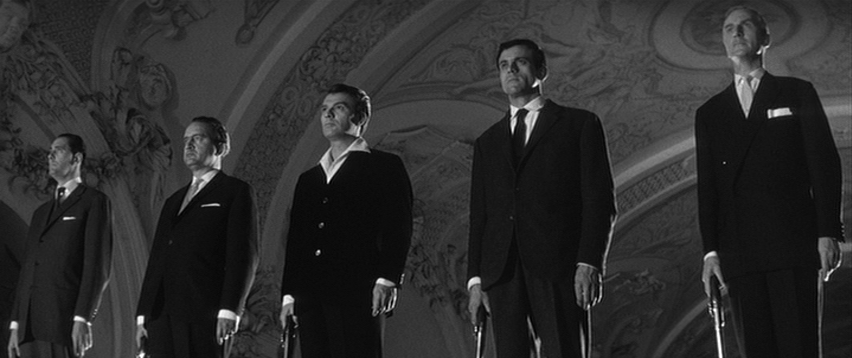

“Along these stone paths and amidst these statues, where you were already losing your way forever in the still night, alone with me.”
A lot of critical ink has been spilled over the last fifty-plus years regarding the mind-bending Last Year at Marienbad. It’s considered by some critics to be one of the highest achievements of arthouse cinema, while others lambast it as nonsensical drivel. If we refrain from a knee jerk reaction—which would probably tend toward taking the latter perspective—and take some time to consider what exactly director Alain Resnais and screenwriter Alain Robbe-Grillet were going for with the confusing script, it begins to make a certain kind of poetic sense. Its complete abandonment of objective narrative is startling in its originality and groundbreaking for its era. It explores the mnemonic tendencies of the human mind, our idiosyncratic mix-ups of random facts and details, the way our memories often replay out of order, repeat themselves, and morph into falsity over time. Its modernist, abstract tendencies may chafe against the sensibilities of the modern popcorn-movie watcher; that’s because it isn’t chiefly concerned with entertaining the viewer, but with exploring themes and ideas, prompting thoughts, and playing with form. In other words, as pretentious as this sounds, it truly is a work of art.

Now, since the film is so abstract, its impact depends nearly as much on the viewer as on the contents of the film; as such, its perceived value will differ wildly between audience members. Unlike standard Hollywood fare, your enjoyment can’t hinge on the plot, because you don’t know which elements of the plot actually exist. Ostensibly, the film is about an unnamed man (Giorgio Albertazzi)—referred to as X in the script—who may or may not have previously met and romantically pursued an unnamed woman (Delphine Seyrig)—referred to as A in the script. At a palace converted to a luxury hotel at Marienbad, X pursues A once again, a year later, beguiling her with episodes pulled from his memory. But both time and space are fluid, and X’s memory proves malleable as well. A second unnamed man (Sacha Pitoëff)—referred to as M in the script—who may or may not be A’s husband, moves in and out of the hazy narrative, routinely displaying his dominance over X by beating him at a mathematical table game. Trying to piece things together is an exercise in futility, doubly so since interviews with Resnais and Robbe-Grillet indicate that it was deliberately designed to not have a single coherent explanation.
Liberated from the constraints of traditional storytelling modes, Last Year at Marienbad gleefully plays with the audience’s conventional expectations. Delphine Seyrig will turn over her shoulder in one shot, the shot will cut as she turns, and in the next shot we are in another room entirely; she may even be in a different costume. The memories that X variably speaks to A or utters in voiceover narration change depending on how A is responding to his advances and the couple’s location on the palace’s premises. It’s almost like a musical composition, with repeated refrains, riffs on similar motifs, and punctual changes of pace.

But the film is not only noteworthy for its narrative experiments and lack of a cohesive plot. It is also stylistically striking and very tightly shot. The film opens at the luxury hotel, a bourgeois gathering of socialites standing stock still as the camera floats about and Albertazzi’s detached voice murmurs about salons, stairs, doors, bygone eras and baroque architecture. It’s visually striking, even more so because of the chiaroscuro lighting effects that remain stylishly daring throughout the film. There are several stunning long takes involving considerable camera movement and a room full of mirrors. These required days of calculations and run throughs to determine where extras had to stand to block the camera from catching itself in the mirror, not to mention the entire crew maneuvering around on all fours. Elsewhere, a dual lens setup was used to capture one face in the foreground and one in the midground without distorting either, an effect that might seem unremarkable today with digital technology but which was achieved in-camera by Resnais and his crew. One of the most memorable images from the film, and one which I find so elegantly captures the theme of false memory, is a surrealistic shot of a tableau. As X and A approach the terrace adjacent to the hotel, a number of still figures stand in the distance, their shadows stretching nearly twice the length of their bodies. But in this skewed memory, the prismatic trees and marble statues cast no shadows at all. It’s a remarkably shifty film, never settling down or letting the viewer have a moment to grasp what they’ve witnessed before pivoting to the next costume, set, or memory.

If we’ve accepted that we know neither where or when we stand in regards to this couple’s relationship, it is still frustrating that we also don’t know anything about the characters at all—a fact that bothered Seyrig, who wasn’t sure how to act her character. But this shouldn’t be unexpected; if we’re experimenting with narrative form, it makes sense to go all the way and similarly toy with setting and character. But like an abstract painting, our human minds still try to project some meaning onto the film, even if, at its core, it is just an experiment with form. While I admire the film’s lofty ambitions, and I think Resnais achieved pretty much everything he set out to do with it, it isn’t exactly riveting. It hits on a pleasantly weird dream-like quality that I greatly enjoyed—one that David Lynch’s entire oeuvre seems aimed toward—but there were times where it seemed to take its experiment a little bit too far and momentarily lost considerable momentum. Maybe that was the intention; in which case, that’s fine—not compelling, though. And that’s where a considerate viewer (someone who has made to a point in the film where they can identify a lull, rather than having already turned it off because it is a pretentious arthouse movie, probably qualifies as such) can zoom out, recognize that this is really a grand experiment, not really crafted for entertainment at all, and appreciate it even if it tends toward tedium. I personally find that conversation about the film and its creation excites me more than actually watching it.

Last Year at Marienbad arose from the same milieu that produced a slew of French New Wave classics—Right Bank films from the Cahiers du Cinéma club like The 400 Blows, Jules and Jim, and Breathless; as well as La Pointe Courte and Resnais’s debut Hiroshima mon amour from the Left Bank. Rebelling against the straight literary adaptations and genericized cinema of the time, both factions of the French New Wave wanted to do something new. Whereas the Right Bank fellows were all young critics who wanted to rebuild things from the ground up, Resnais was able to take his experiences and transform his film into something altogether different.
I won’t deny that it lacks mass appeal. I don’t think you could pull the average joe off the street and expect them to enjoy it. Like most arthouse cinema, it’s an acquired taste. It’s formally daring and historically important, but it’s not something that I would want to watch frequently. So if you’ve been exploring older cinema for a while, or if you particularly enjoyed something similar that plays with memory, time, and space—Persona, The Mirror, 3 Women, Inland Empire—there’s a good chance you’ll appreciate Last Year at Marienbad.
Sources:
Various interviews and commentary. Last Year at Marienbad, directed by Alain Resnais, 1961. The Criterion Collection.